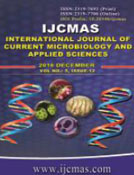


 National Academy of Agricultural Sciences (NAAS)
National Academy of Agricultural Sciences (NAAS)

|
PRINT ISSN : 2319-7692
Online ISSN : 2319-7706 Issues : 12 per year Publisher : Excellent Publishers Email : editorijcmas@gmail.com / submit@ijcmas.com Editor-in-chief: Dr.M.Prakash Index Copernicus ICV 2018: 95.39 NAAS RATING 2020: 5.38 |
The use of natural products as anti-infective agents, have given rise to new chemical diversity and are preferred in modern world. Among all these natural sources, plants and its products is more reliable because of its renewability. Urinary tract infections (UTIs) are among the most common infectious diseases occurring in either the community or healthcare setting. Orange and Plantain peels were used to determine the antibacterial activities. A measure of 50 grams of powder was filled in the thimble and extracted with 150 ml of ethanol successively up to 48 hours. The solvent extracts were concentrated separately under reduced pressure, 2g of each concentrated solvent extracts were dissolved in 20 ml of 20% dimethyl sulphoxide and used for antibacterial assays using agar well diffusion and broth method. The phytochemical analysis of sweet orange peel shows that carbohydrate, reducing sugars, tannins and flavonoids were present, The zone of inhibition effect of the extracts on selected organism was concentration dependent (25<50<75<100). Higher concentration of extract recorded larger/wider effect on each test organism. Musa paradisiacal peel showed no effect on test organism except at 100mg/ml that recorded 4.7±0.47mm against E. coli growth. The MIC and MBC of both orange peel and plantain peels suggest potency against test organisms. Orange peel has advantage over plantain peel;S. aureus, E. coli and P. aeruginosa were susceptible to the extract exempting K. pneumonia, whichshowed no susceptibility to the duo extracts. The peels of Citrus sinensis and Musa paradisiacal exhibited inhibitory activity against certain bacteria, which can be attributed to the presence of certain secondary metabolites. But when compared with standard antibiotics, the ethanoic extracts of the duo was less efficient as there was a smaller size of zone of inhibition against the luxurious growth of tested organisms.
 |
 |
 |
 |
 |